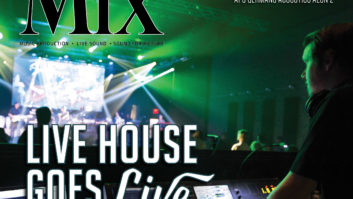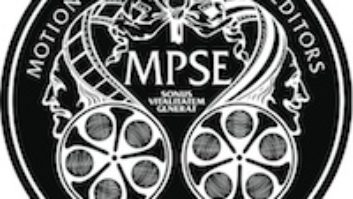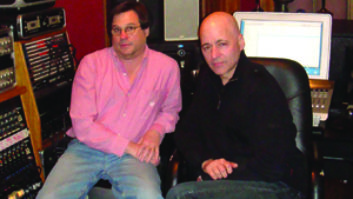BROOKLYN, NY—Here in the creative hotbed of Greenpoint, what may be the ultimate tape-to-disk mastering system is taking shape. Paul Gold, proprietor of Salt Mastering, has recently taken delivery of a 1-inch, 2-track preview deck, thought to be the only one in existence.
Also in the works at Salt, which features a Neumann VMS 66 lathe, is an A/B-path mastering console, which will complete Gold’s big-picture concept for a niche but growing community of audiophile and vinylcentric clients.
Paul Gold with his 1-inch, 2-track preview deck at Salt
Mastering. Behind him is a Neumann VMS 66 lathe. “It’s a preview deck, or ‘pre-listen deck,’ as Studer would call it, for lacquer cutting in a 1-inch, 2-track format,” says Gold. “This machine doesn’t record: it has two playback heads. The first is the preview head, and that feeds the cutting computer, which adjusts the groove spacing and the groove depth. It feeds the cutting computer about a half-revolution before the program head, which cuts the actual audio to the disk, so the computer has time to react and move the motors and solenoid appropriately.

“I thought it was a shame that the users of the format couldn’t get an all-analog cut from their masters,” Gold adds. “It would be nice cutting directly to lacquer without going through a digital delay or going into the computer. This idea to make the 1-inch, 2-track just popped into my head, so I started collecting things to make that happen. I bought an extra 1-inch Studer transport, which was a layback machine for striping audio on 1-inch videotape, because I thought it would be hard to source rollers and things like that.”
With three Studer A80s in his possession, Gold was able to designate the former third “parts” machine—the other two are set up for 1/4- and 1/2-inch tape, respectively—for the 1-inch, 2-track format. He enlisted John French, of JRF Magnetic Sciences, and New York-based technical engineer Dan Zellman to create the preview deck. “I went to Dan with my plan, and he was into it,” Gold recalls. “Dan took care of putting together the transport and working on the transport electronics and audio electronics, and John did the headstack. My instructions were, ‘I want it as good as it can possible be.’ I’m really, really happy with the way it came out, and I think both of them are, too.”
“I used much quieter amplifiers than the original Studer,” Zellman explains. “I went through it completely and updated the circuitry to the point where it’s as good as anything out there, and linear-ized all the frequency response. The response of that machine at 30 ips is plus or minus a quarter of a dB from 40 cycles to 22,000 cycles. At 15 [ips], it extends completely out to the bottom, way below 20 cycles. So it’s going to have the signal-to-noise range of any of the digital equipment that’s out there, but with the added attraction that it’s infinite time resolution, which is what analog is. That also makes it rather superior.”
“We modified the head assembly,” French adds. “We primarily used all of the stock Studer 1-inch rollers from A800s and A80s. We modified the mounting so that they could be adapted. We extended the stock halfinch- type guide up to be able to cover 1-inch, and installed Flux Magnetics extended response 1-inch, 2-track playback heads.”
“John was able to source all these extra rollers—and ceramic rollers— which was really nice, because they don’t wear out,” says Gold. “He also made these fine azimuth adjustors, which are really handy to have.”
Gold cut acetates to test the newly created preview deck in anticipation of its first project, for the band Wheatus. “The mixes were done to DSD,” he says. “[Brendan Brown, of Wheatus] went from DSD to 24/96, and we cut from that. He thought the cut was good, but wasn’t really happy with the DSD—the PCM conversion—so we’re going to do it again and try it from 1-inch. When we did the acetates, he got a big smile on his face when we listened to playback, so I think he’s going to be much happier with it.”
With a largely indie clientele, tape machines and, particularly, the lathe are usually in use at Salt Mastering. The 1-inch, 2-track preview deck adds luster to Gold’s already specialized services. “For mix engineers who like and mix to this format, and for projects going to vinyl, there’s good potential,” Gold observes. “Most people lucky enough to be able to mix to 1-inch are pretty good at what they do. The extensive processing that has to happen in mastering these days probably doesn’t need to happen with the majority of what comes in on 1-inch. Another application I see is other mastering houses that have 1-inch machines and could provide cutting masters on 1-inch instead of high-res PCM.”
But mostly, Gold concludes, “I did it because I wanted to.”
Salt Mastering
saltmastering.com
JRF Magnetic Sciences
jrfmagnetics.com





